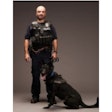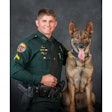Officers need to be aware that graffiti artists, or taggers, may be packing more than a spray can.
Remember graffiti like the World War II vintage, "KILROY WAS HERE"? In the United States, the East Coast was a prime location of subway and train "art" during the early 1970s. The phenomenon spread to the West Coast during the next 15 years. The greatest explosion of graffiti writers and the formation of "tagging crews" happened between 1985 and the mid-1990s. Today, tagging has become an international issue and taggers can be found worldwide. From a law enforcement perspective, it is difficult, at best, to monitor and track all of the individual taggers and tag crews.
In the early years, these groups focused on placing their marks on public and private locations. The goal was to place your crew's tag (name) and your tag as many times as possible. This was considered a way to get recognition, respect and fame among peers and other rival crews. There was very little violent, gang-like conflict reported between these groups during this time.
More Than Creative Writing
By the early 1990s, crews had built a fierce rivalry between themselves and, unfortunately, the existing street gangs. The number of crews and taggers had increased so much in some areas, they were literally running out of room, especially in the larger cities. In addition, it was popular for gangsters, in search of a way out of the street-gang life, to join a tag crew. Also, crews started to place their graffiti within turf that was claimed by traditional gangs. Obviously, to those gangs the presence of tagger graffiti was an insult. All insults had to be dealt with, and we began to see an increase in the number of violent conflicts between the tag crews and street games.
As the number of contacts between crews and gangs increased, so did the number of violent confrontations. Sometimes, crew members would get advice from an ex-gang member on why and how to protect members or to retaliate for a prior assault or insult. In several instances, even though the tag crew would try to refrain from street-gang violence, the constant pressure and threat of the local street gangs would push them into an assaultive mode.
Very quickly, the level of violence rose with each encounter. Crew members, sometimes fueled by drugs like methamphetamine, began to arm themselves with guns for "protection." As one tagger told me in 1992, "They (rival street gangsters) had guns and were shooting at us, so we needed to get guns ourselves, so we could shoot back. We wouldn't go looking for trouble; it would come to us." Gang members have been using the same reason to arm themselves for a number of years.
Tag Bangers
A split began to occur. A new group of taggers emerged who wanted to act like traditional street gangsters, write their graffiti and dump the nonviolent tagger philosophy. The change of philosophy spread rapidly across the country.
The level of violent confrontations with these groups increased, pushing some additional tagger crews to join street gangs for protection or start a gang themselves.
Just as with the street gangs, the gun became a symbol of power and control for the tag banging crews. I have spoken with taggers who tell me they still want to stay away form the violence, but have begun to carry guns to protect themselves in case of a chance encounter with a violent group.
Tag banger gang names changed to reflect the brazen, anti-authority, violent attitudes: "MKA" or Meanest Kings Alive; "STK" or Shoot To Kill; and "2FK" or Too Fucking Krazy. Tag bangers began to walk the walk and talk the talk of traditional street gangs. By the late 1995 there was a clear line distinguishing the tag bangers and tagger crews-the violence.
Officer Safety
Unfortunately, assaults by gangsters on police officers continue to be on the rise, especially in the larger cities. This trend does not make smaller cities or rural towns immune from this problem. In some parts of the nation, gangster assaults on the police have increased 50 percent during the past year.
The point is don't become complacent.
Field contacts with tag bangers should be per procedure and within department policy. Don't assume these gangsters are only into misdemeanor graffiti violations.
Be safe!
Al Valdez is an investigator with the Orange County (Calif.) District Attorney's Office and author of the book, Gangs.








